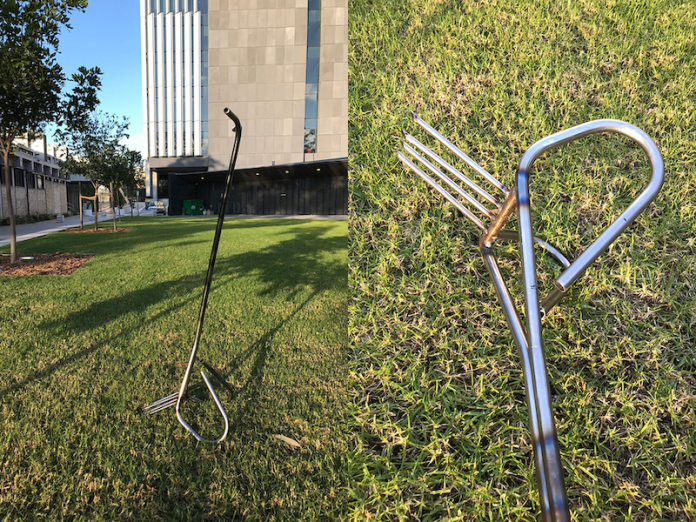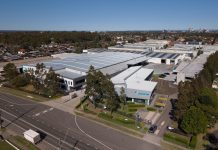
Media Release
A specialised weed management tool for bush regeneration is one of dozens of innovations on display at UNSW’s virtual Luminocity exhibition.
The “lever weeder” – a leverage-based standing weeder for crowning grasses – can improve the efficiency of weed management and assist with vital bush regeneration. UNSW industrial design student Sabrina Piro designed it in response to the catastrophic Australian bushfire season for bush regenerators – a small yet essential industry of people who work to preserve the Australian bush by restoring its natural ecosystems.
Invasive weed species, in particular, can be an unwanted fuel source for bushfires, and can severely impact the survival of native species. In many cases, bush regenerators don’t have the specialised equipment they need to carry out weed management.
“Invasive weeds have a significant impact on the increased intensity of bushfires,” Ms Piro says. “My project was to design a specialised weed management solution for bush regenerators that could improve the efficiency of their practice and overall weed management outcomes.”
The initial concepts and prototypes of the lever weeder’s design were developed in consultation with 20-year bush regenerator Lindy Davis in the Mid North Coast of New South Wales.
“Crude models were made in wood before consulting Lindy and my tutors and workshop staff for feedback. These models then progressed, my design and concept becoming more defined, as I developed steel prototypes,” Ms Piro says. “Lindy has shown great interest in supporting the manufacture of a few of the final prototypes to be used in real bush regeneration work amongst other regenerators.”
The lever weeder will be on display at the annual Luminocity exhibition launching on UNSW Open Day 5 September. This year, the exhibition is a virtual 360-degree tour that blends reality to reimagine locations around the world using the latest in advanced imaging and sensory technology.
The mixed-reality experience takes the visitor on an exploration of the design journey, beginning at the Red Centre Gallery at UNSW, before branching out to different locations across Sydney and the world where student projects from UNSW’s Built Environment degrees solve urban challenges, from the room to the region.
Visitors can experience the virtual 360-degree tour and explore careers in the built environment. Projects from architecture, interior architecture, city planning, computational design, landscape architecture, industrial design, construction and project management will be on display, including:
A coral restoration system (Rory Nagle-Runciman, Industrial Design)
The ‘Coral Cradle’ is a restoration system that allows coral to be re-introduced into an ocean environment. Coral reefs are significantly under threat while methodologies used to “replant” corals are underdeveloped.
The Coral Cradle allows corals to be propagated, transported and easily replanted within the same product. This drastically reduces double-handling processes and allows for the fast cultivation of a thriving reef – an intuitive and elegant design solution to a global problem.
A re-activation of Westmead’s Parramatta River using Indigenous installations (Jonah Darling, Landscape Architecture)
‘Return to the River’ addresses issues of urbanisation, and resulting cultural neglect, by implementing traditional principles of ‘caring for country’ in a linear waterfront setting.
The landscape design aims to reactivate Westmead’s Parramatta River corridor, a convergence of traditional clans and natural systems, by reclaiming natural resources and establishing new cultural opportunities. It shows how Australian cities can use urban design to strengthen multiculturalism and land care.
An urban interaction design to reduce cyclists’ speed (Scarlett Rogers and Stefen O’Neil, Computational Design)
‘The Rumble Strip’ is an urban interaction design to reduce the speed of cyclists, while providing a safer environment for pedestrians at all hours of the day.
The system works in two ways. The first incorporates haptic feedback, using uneven cobblestone-like pavers to make the road uncomfortable for cyclists travelling above 10 km/hr. The second uses LED lights built into the grout around the pavers, activated by sensor, that change colour and provide cyclists with a visual cue of their speed.
A cultural gateway to historic Sofala in regional NSW (Jenny Lin, Architecture)
‘Re-Framing Sofala’ creates a gateway to the historic village of Sofala NSW situated in the Turon River valley. The proposal unfolds through streets and squares to provide diverse social opportunities along the tree-lined hillside.
The open square facilitates a gentle transitional experience for visitors between the main street, the steep hill and the river below to provide the public with a place for leisure and outdoor activities. Inside the gallery, openness is established via courtyards and enfilades that allow views of the circulation and display spaces.
Read the media release here.


















